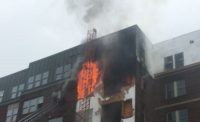Due to this behavior, conventional design approaches are not necessarily conservative, as assumed, says Rein. The research indicates that the worst-case scenario would be a fire traveling with a size 10% to 25% of the floor area.
The traveling-fire methodology uses simple analytical calculations coupled with a finite element model. Computational fluid-dynamics modeling confirms the results, says Rein. Using a PC or a laptop, engineers trained in the methodology can model the behavior of a two- to three-hour fire over an entire floor in two or three days. A computer cluster can accelerate the modeling to several hours. More costly cloud computing can almost model in real time, says Rein.
Five people are trained in applying the methodology: Rein and four engineers at Arup, including his two former Edinburgh Ph.D. students-researchers, Angus Law, currently at Arup Leeds, and Jamie Stern-Gottfried, currently at Arup Berlin.
Rein is seeking funds to produce a guide that explains the methodology. He figures it is a three-year project.
Each analysis is building-specific. This can result in a more cost-effective design, with protection tailored to the threat, says Rein. The method compliments the traditional method, he adds.
Arup has applied the approach to a half-dozen projects. It recommends contacting the authorities having jurisdiction as early as during conceptual design. The analysis is more involved and costs more than a prescriptive approach, says Arup, but it potentially increases the flexibility of the architecture while increasing the structure's robustness.
Morgan J. Hurley, technical director for the Society of Fire Protection Engineers, Bethesda, Md., has some issues with the traveling-fire method. It is difficult to predict the way a fire will travel because travel is based on the number of openings, such as broken windows, and that is an unknown, he explains. Similarly, the distribution and type of fuel—building contents—influence fire behavior.
In response, Law says the method allows Arup to predict a range of possible scenarios for any particular building.
The Edinburgh research has been peer-reviewed, but it hasn't gone through the full standardization process. An effort to include it in the Eurocode is beginning. Once that happens, the method will be transferable to the U.S. Says Hurley, "The fire doesn't care if the building is in the U.K. or Spain or New York City."
This summer, ASCE's fire committee chair, Maria Garlock, expects to present the proposed PBD appendix to the main ASCE 7 committee for balloting. Its future is uncertain, says Garlock, a professor of civil and environmental engineering at Princeton University. Seeing potential liability, structural engineers, not typically trained in fire engineering, may resist even a non-mandatory appendix.






Post a comment to this article
Report Abusive Comment